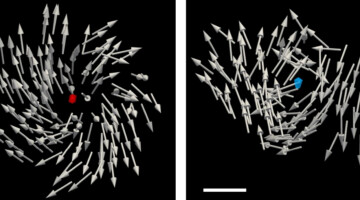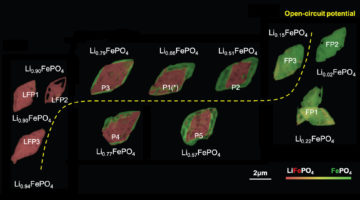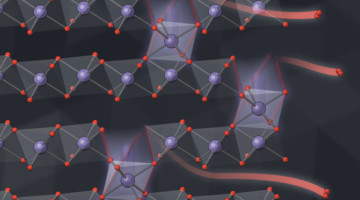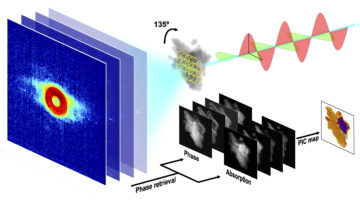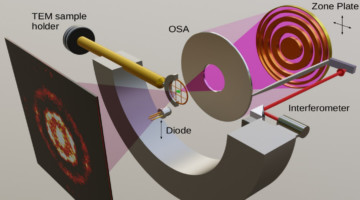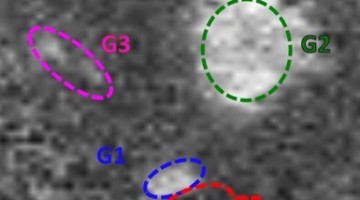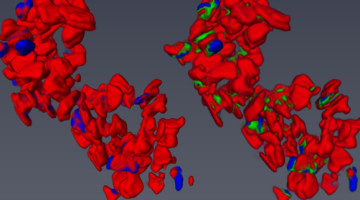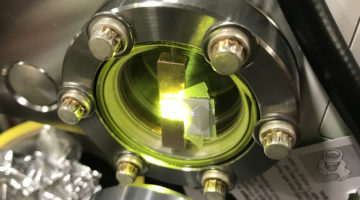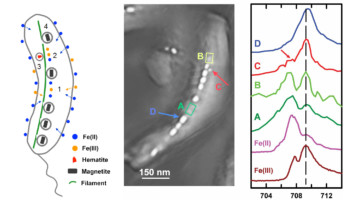Researchers created topologically stable magnetic monopoles and imaged them in 3D with unprecedented spatial resolution using a technique developed at the ALS. The work enables the study of magnetic monopole behavior for both fundamental interest and potential use in information storage and transport applications. Read more »![]()
![]()
ALS Work Using Ptychography
Ptychography uses coherent diffraction patterns recorded from fields of illumination that are physically overlapped on an extended sample, with known separation. This information is used in the iterative reconstruction of phase, and results in a robust and unique solution that gives the local complex refractive index of the object and the complex illumination function. Through phase retrieval from diffraction data, ptychography can in principle overcome the limitations of x-ray optics, namely limited efficiency and numerical aperture.
A Machine-Learning Approach to Better Batteries
Researchers extracted the relationship between strain and composition in a battery material by applying machine-learning methods to atomic-scale images. The work could lead to more durable batteries and also highlights the potential of integrating microscopy techniques with machine learning to gain insights into complex materials. Read more »![]()
![]()
A Multiscale Picture of Oxygen Loss in Battery Electrodes
In lithium-ion batteries, oxygen atoms leak out of electrode particles as the lithium moves back and forth between electrodes. Now, researchers have measured this process at multiple length scales, showing how the oxygen loss changes the electrode’s structure and chemistry, gradually reducing the amount of energy it can store. Read more »
Coral Skeleton Reveals Hidden Structures under Multimodal Scrutiny
A powerful new microscope combining ptychography with x-ray linear dichroism provides nanoscale insight into the biomineral strength and resilience of a coral skeleton. The technique’s previously unachievable spatial resolution and contrast will open up new lines of research for users of x-ray microscopy at the ALS. Read more »
A COSMIC Approach to Nanoscale Science
COSMIC, a multipurpose x-ray instrument, has made headway since its launch less than two years ago, with groundbreaking contributions in fields ranging from batteries to biominerals. Its capabilities include world-leading microscopy resolution, extreme chemical sensitivity, and ultrafast scanning speed. Read more »
Nanoscale Characterization of Iron and Calcium in the Alzheimer’s Brain
The amyloid plaques that accumulate in Alzheimer’s disease contain stores of iron. Using scanning transmission x-ray microscopy, researchers have characterized the iron’s chemical states in unprecedented detail. Their nanoscale analysis revealed excessive chemical reduction of the iron, which can release damaging free radicals. Read more »
3D Localization of Nanoscale Battery Reactions
A new tool lets researchers pinpoint the locations of chemical reactions happening inside batteries in three dimensions at the nanoscale level. Combining ptychography, tomography, and spectroscopy, Nanosurveyor 1 is a multidimensional tool providing novel insight into the design of next-generation batteries and devices. Read more »
COSMIC Impact: Next-Gen X-Ray Microscopy Platform Now Operational
After a first-year ramp-up for testing and tuning components, COSMIC is now operating at the ALS. The beamline brings together unique capabilities to measure the properties of materials at the nanoscale, and scientific results from its earliest experiments are expected to be published later this year. Read more »
Ptychography of a Bacterium’s Inner Compass
Magnetotactic bacteria (MTB) synthesize chains of magnetic nanocrystals (magnetosomes) that interact with the Earth’s magnetic field like an inner compass needle, simplifying their search for optimum environments. Ptychographic spectra of magnetosomes from a marine MTB provides insight into how these inner compasses form. Read more »
2015 Director’s Awards
ALS staff took top honors in Lawrence Berkeley National Lab’s 2015 Director’s Awards for Exceptional Achievement and were recognized in a ceremony earlier this month. The ALS recipients comprised nearly half of this year’s awardees, receiving recognition in the scientific, early scientific career, and safety categories. The Director’s Awards honor individuals in both the scientific and operations divisions forRead More Read more »
